Ijraset Journal For Research in Applied Science and Engineering Technology
- Home / Ijraset
- On This Page
- Abstract
- Introduction
- Conclusion
- References
- Copyright
Effect of Stress Levels and Temperatures on Stress Recovery of Asphalt Binders
Authors: Shoaib Mujtaba, Imran Hafeez
DOI Link: https://doi.org/10.22214/ijraset.2023.48781
Certificate: View Certificate
Abstract
HMA\'s rut resistance comes from the asphalt binder and aggregates. Rutting, which causes depressions in hot-mix asphalt (HMA) pavements along wheel paths, is a common type of distress. Both the loading and recovery phases of asphalt pavement performance are significantly impacted by the asphalt binder. In contrast to the extensive study conducted during the loading phase, the recovery phase receives comparatively little attention. Percent recovery tests asphalt binder elastic behaviour and stress dependence. Asphalt binder can self-repair and improve over time. Using a dynamic shear rheometer\'s multiple stress creep recovery method, virgin and modified asphalt binder were compared. Different temperatures and stresses were applied to the asphalt binders, and their responses were analysed. The results of the tests showed that the retrieval proportion of asphalt binder could be significantly increased by using admixtures, nanostructured materials, and viscous fluids. This case study shows that unmodified binders do not exhibit significant sensitivity to stress or strain under reasonable stress or tension conditions, nor do they showed considerable restoration under creep conditions; as a result, MSCR testing is not required for testing unmodified binders. Because of its potential as a modified binder performance indicator, Super Pave binder specification includes it. Furthermore, the data presented above demonstrates that certain modified binders provide better percentage recovery than neat binders. The viscous fluids were the ones that performed the best out of all the samples that we examined, closely followed by the nanostructured materials and the virgin binders.
Introduction
I. INTRODUCTION
The asphalt binder in hot mix asphalt (HMA) is what gives the mixture its performance characteristics like rutting resistance. One of the most common types of distress in warm asphalt (HMA) pavement structure is permanent deformation, also known as rutting, which appears as depressions in the pavement surface along the wheel paths. Rutting can reduce ride quality and increase the risk of hydroplaning, which can lead to serious accidents.
There is a strong correlation between the asphalt binder's performance and the loading and retrieval stages of asphalt pavements. Loading has been the primary area of investigation; however, much less attention is paid to the recovery phase when compared with the loading phase. As with other time and temperature sensitive mixtures, asphalt mixture experiences a range of temperatures over the course of its lifetime. At low temperatures, it exhibits elastic behaviour, and at high temperatures, it displays viscous behaviour, demonstrating the viscoelastic properties in general.
In order to ascertain whether or not the asphalt binders under study exhibit elastic response and stress dependence, researchers use the percent recovery as a metric. Asphalt binder has the capacity to self-repair, meaning that its performance improves, and its distress level decreases over time. If a sample is repeatedly stretched and relaxed, the percentage recovery indicates how close the sample comes to regaining its initial shape.
The capacity to relax is crucial for boosting asphalt mixture design, enhancing construction methods, and extending the life of asphalt pavements. Another major issue with asphalt pavement is rutting, or permanent deformation, especially in hot climates, where it builds up quickly in the first few years of the pavement's life before slowing down. Pavement temperature is important for design. Because asphalt concrete stiffness directly affects strains, mid-depth pavement temperature can predict pavement performance. Asphalt pavement cracks, deforms, and more due to its temperature sensitivity. Temperature-based distresses will reduce pavement performance, safety, lifespan, and agency and user costs. Alligatoring, rutting, corrugation, shoving, and other traffic loading exacerbate environmental damage. It deeply affects the surface and subsurface. Thermal cracks worsen under vehicle loading and lead to new distresses like alligator and fatigue cracking, which cause structure distresses and accelerate pavement deterioration.
Since more and more high-quality modified asphalt binders are being used in pavements, it has become clear that the current standards used to grade asphalt binders are not always up to the task. The "Federal Highway Administration (FHWA)" has created a performance-based PG binder test, the "Multiple Stress Creep and Recovery (MSCR)" test, to characterise asphalt binder properties related to HMA rutting in order to address this problem. samples of asphalt binders are subjected to a creep and recovery performance test known as the MSCR. The test is capable of characterising the asphalt binder's recovery and non-recovery compliances. There is strong evidence linking the MSCR to HMA rutting performance, and several studies back this claim. A conventional DSR machine can also be used to test for MSCR quickly and easily.
II. objectives
The goals of this study are to:
- To review the impact of temperature on percentage recovery or recuperation of asphalt binders.
- To review the impact of various stress levels on percentage recovery or recuperation of asphalt binders.
- To develop and study a relationship among the stress levels, temperature, and percentage stress recovery.
III. Research methodology
- Phase I: In the first phase of the research the material was selected. Three types of material were selected: Virgin Binders e.g., ARL 60/70, Viscous Liquids e.g., Bon Glue, Olive Oil and Nano Composites e.g., Graphene, C.P 3%.
- Phase II: In the second phase of the research the material specimen was prepared.
- Phase III: In the third phase the of the research the MSCR tests were performed on the above-mentioned prepared samples. The MSCR test data was observed and recorded.
- Phase IV: In the fourth phase of the research the collected data was analyzed to find the conclusions.
- Phase V: In the fifth phase the required calculations were done and test results for virgin and modified binders were organized. This was made possible through plotting data in different graphs and tables.
- Phase VI: In the sixth and final phase of the research the % Recovery was determined for virgin and modified binders. Through MSCR test the behavior of binders was studied under different temperature and stress levels and their % Recovery was calculated and plotted in the graphs.
IV. material & testing
A. Materials
- Virgin asphalt hot mix asphalt (HMA) is a material used for paving roads, walkways, parking lots, driveways, and even airstrips. It is created by heating and mixing together abrasive and delicate aggregates (crushed rock), filler (dust and/or hydrated lime), and bitumen in a mixing or batching plant while hot. Both ARL 60/70 and NRL 80/100 originate at the Attock Oil Refinery.
- Carbon nanoparticles (CNPs) are made entirely of carbon and exhibit exceptional stability, superior electrical and thermal conductivity, excellent mechanical properties, low toxicity, and a low impact on the environment.
- Nanocomposites materials with nanoparticle reinforcement that contain up to 5% nanoparticles by weight. Nanocomposites have the potential to improve the polymer's performance and properties, thanks to their high aspect ratios.
Table 1 Types of Materials
|
Virgin Binders |
Viscous Fluids |
Nano Composites |
|
ARL 60/70 |
Bio oil |
C.P 3% |
|
NRL 60/70 |
Bon glue |
CNP |
|
NRL 80/100 |
Chamseal |
GNP |
|
PARCO 60/70 |
Olive oil |
CNT 25% |
|
|
Chamflex E.R Expanseal
|
Grapheen
|
B. Testing
- Multiple Stress Creep Recovery Test
"Multiple Stress Creep Recovery" Testing was done on the aforementioned asphalt binder materials. The MSCR test is based on the tried-and-true creep and recovery test concept, and it is used to determine the binder's true capacity for long-term deformation. The asphalt binder sample is subjected to a creep load of one second using a "Dynamic Shear Rheometer (DSR)", a device similar to that used in the modern PG specification. Following the removal of the 1-second load, the sample is given 9 seconds to recover or recuperate. General data for a polymer-modified binder is depicted in Figure 1. Ten creep or recovery cycles are performed at a low stress (0.1 kPa), followed by ten more at a higher stress (3.2 kPa).
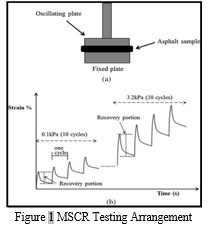
2. Calculating the Percent Recovery (% Recovery)
During the creep interval, a material is subjected to a load (stress) for a specified portion of time while the subsequent deformation (strain) is estimated. The recovery interval promptly follows the creep interval wherein the load (stress) is eliminated and the backlash (recovery) of the material is estimated. The controlled and estimated specifications are applied stress and resulting strain. The creep time period 1 second. The recovery time frame 9 seconds. For a complete process duration of 10 seconds.
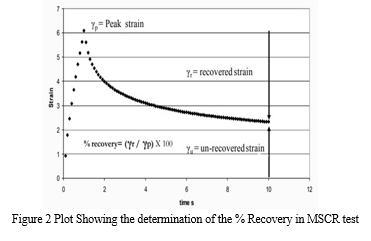
V. Results & analysis
A. Effect of Temperature on Percentage recovery of Asphalt Binders
The graphs that follow illustrate how temperature influences the amount of asphalt binder that is recovered as a percentage. The graph clearly shows that as the temperature rises, there is a corresponding drop in the percentage of recovery.
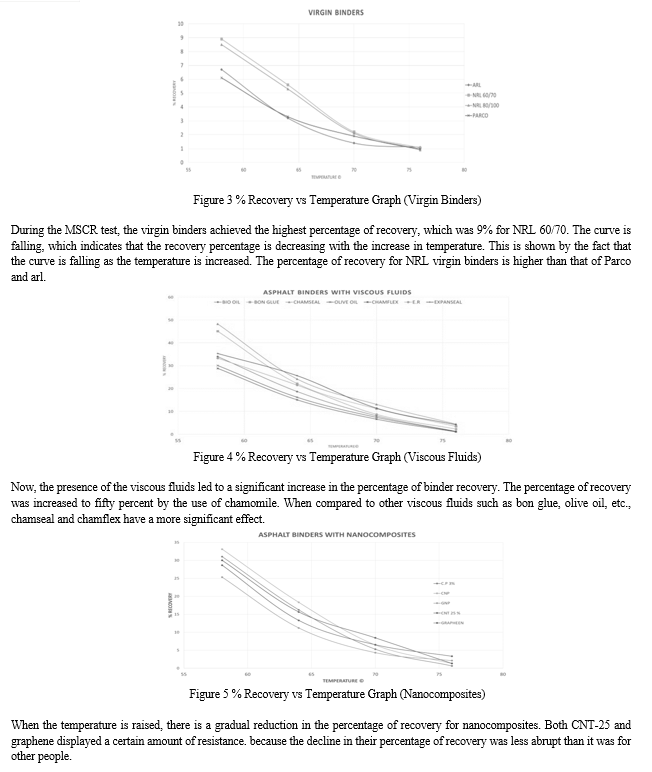
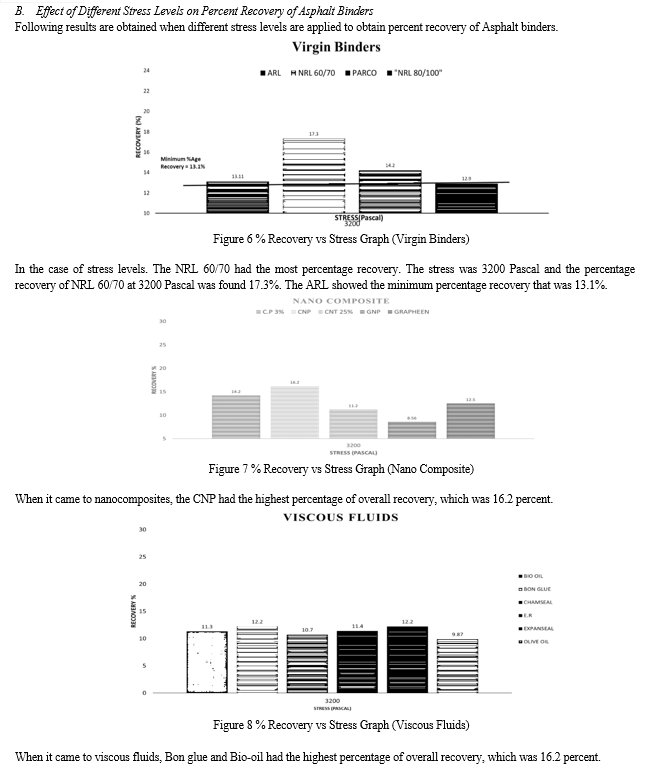
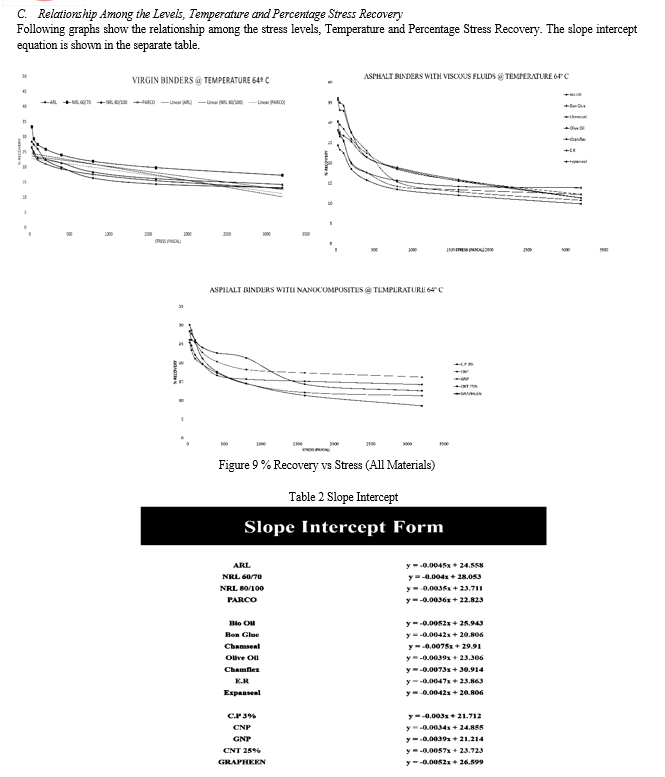
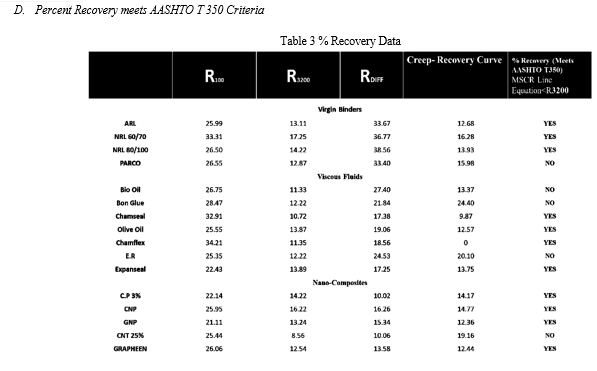
Conclusion
With the increase in temperature, percent recovery has showed a significant decline. Virgin binders have performed the worst among the three categories when subjected to high temperature followed by viscous fluids and Nanocomposites. ARL percent recovery at 58°C is 7%, while it shows values of 5.3% and 3% at 64°C and 70°C respectively. Moreover, NRL and PARCO have also shown significant decline when subjected to high temperatures; therefore, MSCR testing is not required for testing of unmodified binders. From the discussion above, it can also be concluded that certain modified binders perform better than neat binders as far as the percentage recovery is concerned when subjected to high stress. Among virgin binders, PARCO has shown the least recovery when subjected to increase in stress i.e. 12.9% followed by NRL (17.3%) and ARL(13.3%). Similarly, among viscous fluids, bonglue (12.2%) and bio oil (12.2%) have shown greater recovery than the rest. Among nano-composites, Graphene (12.5%),C.P(14.2%) and CNP(14.2%) have shown significant recovery than the rest, however, CNT and GNP have failed to meet the threshold for minimum recovery i.e 11.0%. Thus, viscous fluids have performed the best among the tested specimen, followed by nanocomposites and virgin binders. The elastic performance of the modified binders was improved by the addition of additives, as asphalt binders showed higher %R values than the conventional binders with better recovery percentages. All of these efforts are aimed at better characterization of rutting performance of asphalt binders.
References
[1] Rong Chang, Aimin Sha, Pinxue Zhao, Songchang Huang, Cong Qi, \"Evaluation of Susceptibility of Asphalt Binders to Rutting through MSCR Test\", Advances in Materials Science and Engineering, vol. 2021, ArticleID 1532994, 10 pages, 2021. https://doi.org/10.1155/2021/1532994 [2] Walubita, Lubinda & Martinez-Arguelles, Gilberto & Chunduri, Harshavardhan & Gonzalez, Jose & Fuentes, Luis. (2020). Statistical Evaluation of the Material-Source Effect on the Ductility and Elastic Recovery (ER) of Plant-Mix Extracted Asphalt-Binders. Advances in Civil Engineering. Volume 2020. 12. 10.1155/2020/8851691. [3] Hanqi Liu, Waleed Zeiada, Ghazi G. Al-Khateeb, Abdallah Shanableh, Mufid Samarai, Use of the multiple stress creep recovery (MSCR) test to characterize the rutting potential of asphalt binders: A literature review, Construction and Building Materials, Volume 269, 2021, 121320, ISSN 0950-0618, https://doi.org/10.1016/j.conbuildmat.2020.121320. (https://www.sciencedirect.com/science/article/pii/S0950061820333249) [4] Xue Luo, Fuquan Ma, Bjorn Birgisson, Zhiyi Huang,Coupled mechanical and kinetic modeling of recovery in asphalt mixtures, Construction and Building Materials, Volume 254, 2020, 118889, ISSN 0950-0618, https://doi.org/10.1016/j.conbuildmat.2020.118889. (https://www.sciencedirect.com/science/article/pii/S0950061820308941 [5] Bahia, H. U., Zhai, H., Zeng, M., Hu, Y., and Turner. Development of Binder Specification Parameters Based on Characterization of Damage Behavior. Journal of the Association of Asphalt Paving Technologists, Vol. 70, Louisville, Kentucky, 2001, pp. 442-470. [6] Walker, D. Refining Superpave Asphalt Binder Characterization. The Magazine of Asphalt Institute, Lexington, KY, 2011. http://www.asphaltmagazine.com/news/detail.dot?id=7b49974f-eeb9- 4db3-82bc-67f0085227fe. Accessed July 14, 2014 [7] Oliver, J., and Tredrea, P. Relationship between Asphalt Rut Resistance and Binder Rheological Properties. Journal of the Association of Asphalt Paving Technologists, Vol. 67, Louisville, Kentucky, 1998, pp. 623–637. [8] Bahia, H. U., Hanson, D. I., Zeng, M., Zhai, H., Khatri, M. A., and Anderson, R. M. Characterization of Modified Asphalt Binders in Superpave Mix Design. Project No. 9-10 FY\'96, Transportation Research Board, Washington, D.C., 2001. [9] Polacco G., Berlincioni S., Biondi D., Stastna J., ZanzottoL, 2005. “Asphalt modification with different polyethylene-based polymers”, European Polymer Journal - EUR POLYM J , vol. 41, no. 12, pp. 2831-2844. [10] Mogawer W., Austerman A., Kutay A. 2011. “Evaluation of binder elastic recovery on HMA fatigue cracking using continuum damage and overlay test based analyses”. J Road Mater Pavement. 12(2):345–76. [11] Kim, Y. R. 2008.“Modeling of asphalt concrete”, McGraw-Hill Professional, ISBN-10: 007146462X, ISBN-13: 978-0071464628, Edition: 1.
Copyright
Copyright © 2023 Shoaib Mujtaba, Imran Hafeez. This is an open access article distributed under the Creative Commons Attribution License, which permits unrestricted use, distribution, and reproduction in any medium, provided the original work is properly cited.

Download Paper
Paper Id : IJRASET48781
Publish Date : 2023-01-21
ISSN : 2321-9653
Publisher Name : IJRASET
DOI Link : Click Here
 Submit Paper Online
Submit Paper Online

